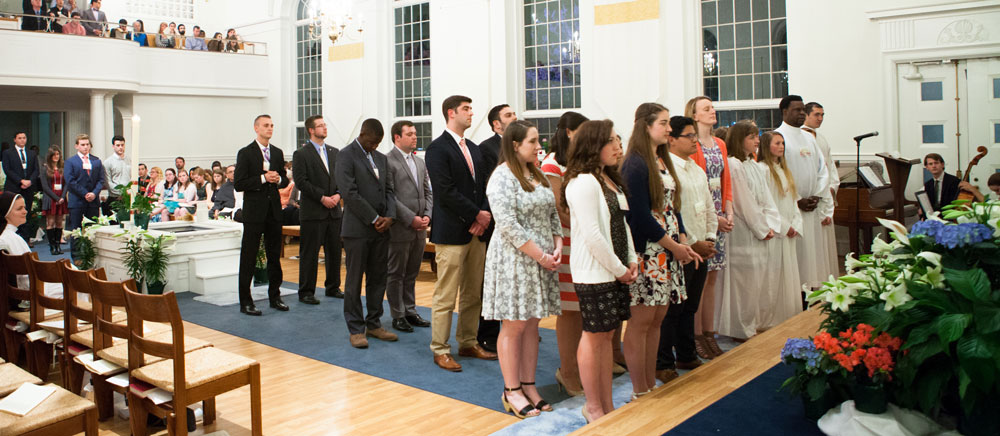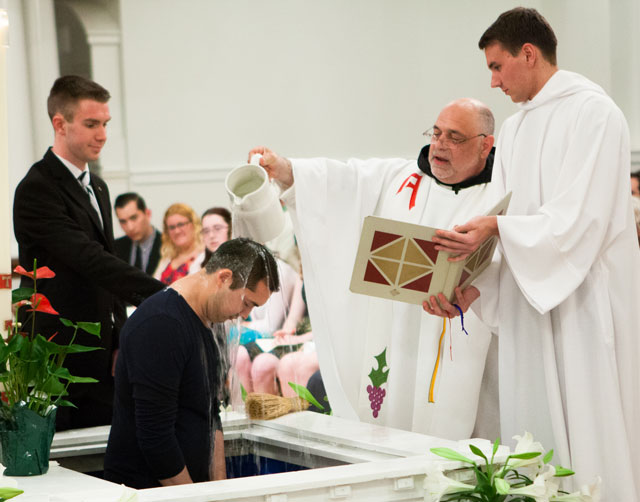
Junior Anna Mohler was a little nervous as she stood in front of friends, family, and classmates during this year’s Easter Vigil Mass at St. Vincent’s Chapel. After months of preparation, including weekly Rite of Christian Initiation of Adults (RCIA) classes, she was there to profess her baptismal vows and officially join the Catholic Church.
Though she had participated in a rehearsal earlier in the day, Mohler was surprised by the symbolism and dramatic beauty of the vigil, which began in a dark church. After a series of seven candle-lit readings from the Old and New Testaments, the lights came back on during the Gloria, symbolizing Christ’s resurrection from the dead.
“I think that was the most special part,” Mohler said. “It was really fun to experience that and to have so many close friends from campus with me.”
Mohler, who grew up Methodist, had long felt a connection to Catholicism. For her, the Easter Vigil was an opportunity to join the Church she had studied and prayed about for years.
“I’m looking forward to being able to go to a Mass or talk with a priest or sister and not feel like there’s a wall separating us,” Mohler said. “Being able to receive the Eucharist is really exciting to me.”
Mohler was one of five CUA students who received the sacrament of baptism during the Mass. In addition, six students entered into full communion with the Church and four received the sacrament of confirmation. In the months leading up to the Mass, all 15 students participated in weekly RCIA classes taught by Rev. Eric de la Pena, the University’s associate chaplain for faith development.

The RCIA program averages 10 to 15 students a year. This year, for the first time, it was standing room only at the Easter Vigil because many of the candidates' family members were there even though most of them are not Catholics, noted Father de la Pena.
As part of RCIA, students met in a group every Sunday beginning in the fall. They attended Mass together and shared discussions of sacraments, scripture, morality and other aspects of Catholicism. Often the classes included guest lectures from University faculty and a shared meal.
“What we call RCIA is a process, not a program,” said Father de la Pena. “It’s really a process of coming to God, a process of conversion, and a process of opening oneself more and more to the grace of God so that one can become part of that faith community.”

“It’s all about giving you a basis of what you need to know to be a baptized Christian,” said freshman Anthony Vincent, who participated in RCIA to prepare for his confirmation during the Easter Vigil. “It sets the framework for the Catholic Church and what it takes to be a member and prepares you spiritually to be introspective and learn how to pray.”
Baptized and raised in the Lutheran church, Vincent said he began RCIA because he had always felt drawn to Catholicism.
“I went to a Catholic high school and I found it was something I wanted to pursue,” he said. “Through my own faith life and questioning myself, I realized I wanted to be a part of the Church I’d been learning about for the past four years.”
In addition to RCIA, Vincent has grown spiritually throughout his freshman year with the help of Campus Ministry service events and his teachers in the School of Nursing, who have taught him the importance of spirituality in healthcare. When Pope Francis visited the University last September, Vincent said it gave him an extra push to finally join the Church.
“Coming to Catholic University, I have opportunities I wouldn’t get otherwise,” Vincent said. “Since I came here, it’s great that I have this opportunity to be as Catholic as I want to be.”